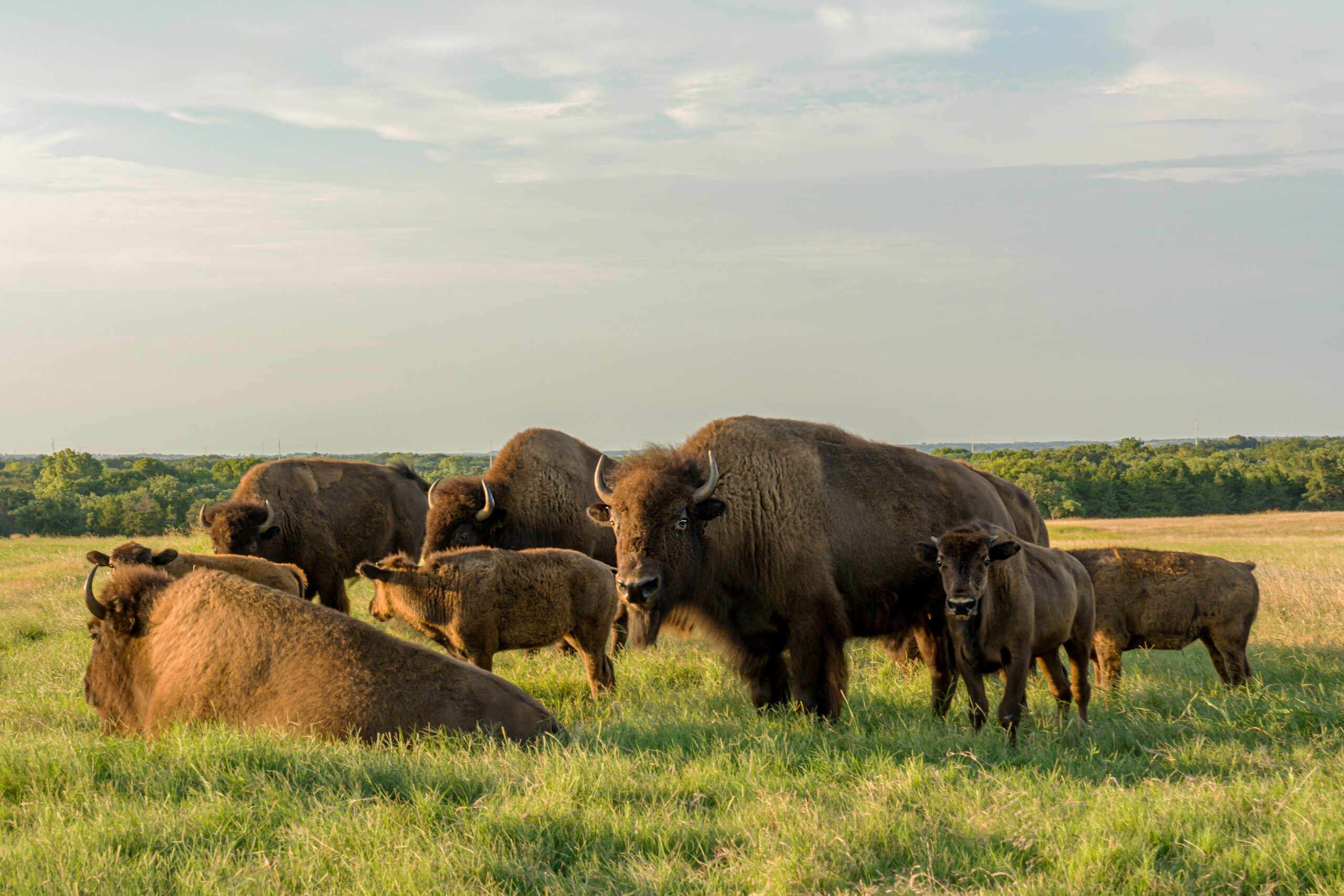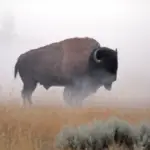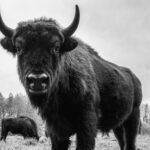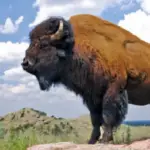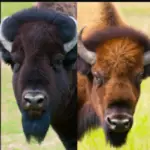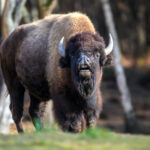Male-Dominated Herd Structure
American bison herds, known as “bands,” exhibit distinct social structures. These herds are often male-dominated, consisting of adult males, females, and their offspring.
Adult males, known as bulls, compete for dominance through displays of strength and aggression. The dominant bull typically leads the herd, ensuring the safety and well-being of the group.
Female bison, known as cows, form smaller family groups within the larger herd, providing protection and care for their calves. These social structures influence the bison’s habitat usage, as the dominant bull determines the movements and grazing patterns of the entire herd.
Mating and Breeding Patterns
Mating and breeding patterns have a significant impact on the American bison’s social structure and habitat usage. During the breeding season, dominant males establish territories and engage in intense competition for access to receptive females.
This behavior, known as the rut, influences the movement and dispersal of bison herds, often triggering long-distance migrations in search of mating opportunities. The mating patterns and success of dominant bulls shape the genetic diversity and population structure of American bison herds.
Understanding these reproductive behaviors is essential for effective habitat management and the conservation of the species.
Social Structure’s Impacts on Habitat Usage
The social structure of American bison herds directly affects their habitat usage. Dominant bulls play a crucial role in determining the movements, grazing patterns, and habitat selection of the entire herd.
The availability of suitable habitats for grazing, shelter, and reproduction influences the behavior and decisions of the dominant bull. The hierarchical relationships within the herd dictate the distribution of resources, such as access to food and water sources.
The social dynamics and interactions between individuals are critical factors in the bison’s ability to adapt to changing environmental conditions and ensure the sustainability of their habitat.
Impacts of Disease on American Bison Habitat
Bovine Tuberculosis
Bovine tuberculosis (bTB) is a contagious bacterial disease that can impact the American bison’s health and habitat. Bison herds can serve as reservoirs for the disease, potentially transmitting it to domesticated livestock and other wildlife species.
Outbreaks of bTB can result in the culling or removal of infected bison, affecting the population size and social structure of herds. Disease management strategies, such as testing, vaccination, and quarantine measures, are crucial for minimizing the impact of bTB on the health of bison populations.
By reducing the prevalence of bTB in bison herds, conservation efforts can help ensure the stability of these iconic animals’ habitats.
Brucellosis
Brucellosis is another disease that can impact the American bison’s habitat. This bacterial infection primarily affects pregnant females, potentially leading to abortion or reduced reproductive success. The presence of brucellosis in bison herds can have implications for the sustainability of their habitat by affecting population dynamics, genetic diversity, and social structures.
The management of brucellosis in bison populations involves testing, vaccination, and maintaining a buffer zone between bison and livestock in areas where transmission is a concern. These measures are essential for safeguarding the health of bison herds and their habitats, as well as preventing transmission to other wildlife and livestock species.
Parasitic Infections
Parasitic infections can pose challenges to the American bison’s habitat and overall well-being. External parasites, such as ticks and lice, can cause irritation, discomfort, and potential disease transmission among bison populations. Internal parasites, like gastrointestinal worms, can impact the bison’s nutritional health and result in reduced fitness.
Maintaining a balanced ecosystem, with healthy predator-prey relationships and a diverse array of wildlife species, can help control parasite populations and minimize their impact on the bison’s habitat. Conservation efforts that prioritize habitat preservation, wildlife corridors, and sound ecosystem management are crucial for mitigating the risks associated with parasitic infections.
Why Do American Bison and Antelope Prefer Grazing Habitats?
The grazing bison and antelope habitat is favored by American bison and antelope due to several reasons. These habitats provide an abundance of grasses and forbs, which are their primary food sources. Grazing habitats also offer wide open spaces that allow for easy movement and surveillance, enabling these animals to detect and escape potential predators effectively. Additionally, the diverse vegetation in grazing habitats ensures a constant food supply throughout the year, making them ideal for bison and antelope to thrive.
American Bison in Captivity
Zoological Parks and Display
American bison are often found in zoological parks and exhibits, providing opportunities for educational experiences and wildlife conservation initiatives. Zoos play a role in the captive breeding and management of bison populations, ensuring genetic diversity and long-term sustainability.
By showcasing these iconic animals, zoological parks raise awareness about the importance of their habitat conservation and promote public engagement in conservation efforts.
The well-being and health of bison in captivity require the provision of suitable habitats, social enrichment, and proper care to mimic their natural behaviors and support their overall welfare.
Farming and the Bison Industry
The bison industry has emerged as a unique aspect of bison conservation. Commercial farming of bison for meat, leather, and other products has provided an economic incentive for landowners to conserve and protect habitat for these animals.
Bison ranching practices often prioritize sustainable land management, grassland restoration, and adherence to animal welfare standards.
These farming operations contribute to the conservation of the American bison by promoting their ecological role, genetic diversity, and habitat preservation. Balancing the economic opportunities presented by the bison industry with the need for conservation is essential for the continued coexistence of bison and their habitats.
Impacts of Captivity on Lifespan and Health
While captivity can provide a safe and controlled environment for some American bison populations, it can also have impacts on their lifespan and health. The accessibility to veterinary care, protection from predation, and provision of food and shelter can contribute to higher survival rates and increased longevity in captive bison.
However, challenges such as stress, limited space, and reduced genetic diversity can also arise in captivity. The development and implementation of best management practices, including enclosures that mimic natural habitats and enrichment activities, are crucial for minimizing the potential negative effects of captivity on bison health and ensuring their overall well-being.
In conclusion, the history of the American bison’s habitat reflects their remarkable adaptability and resilience in the face of significant challenges.
From the vast prairies and woodlands of the pre-Columbian era to the protected habitats of national parks today, the American bison has managed to persist despite habitat loss, climate changes, and human impacts. Conservation efforts, collaboration between diverse stakeholders, and a deeper understanding of the ecological interactions are crucial for ensuring the long-term survival of the American bison and the preservation of their unique habitats.
By valuing and protecting these majestic creatures, we contribute to the conservation of a species that is not only an iconic symbol of North America but an essential component of thriving ecosystems.

